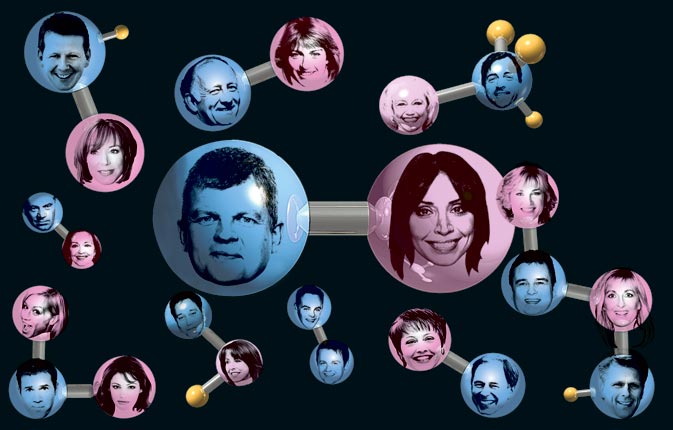A Question of Chemistry: On-screen partnerships
Next week sees the debut of a multimillion-pound pairing of star television hosts. But does ITV have the formula right? Brian Viner on the science of on-screen partnerships

On Monday, amid a barrage of newspaper and television advertising, ITV launches its new breakfast show, Daybreak, hosted by the former presenters of BBC1's The One Show, Adrian Chiles and Christine Bleakley.
There has been much comment about the substantial compensation the pair will receive for getting up very early in the morning – Chiles is reportedly being paid £6m over four years by ITV, which also covers his duties as the channel's new football anchorman, and Bleakley £4m over three years – but both deny being lured from the BBC by "suitcases of cash". For Chiles it was an artistic decision; he is said to have been miffed when Chris Evans got The One Show gig on Fridays. And Bleakley apparently left because she missed working with Chiles.
Whatever, the considerable investment that ITV has made in the pair shows how elusive and valuable is that nebulous phenomenon, on-screen chemistry, in the area of television where light entertainment meets current affairs. Certainly, Chiles and Bleakley have oodles of it, as, in the early days of breakfast TV, did Anne Diamond and Nick Owen. So, too, do the direct rivals of the new Daybreak presenters, Sian Williams and Bill Turnbull on BBC Breakfast, although Turnbull often looks uncomfortable with a stand-in.
There is no simple equation. Two strong broadcasters, engaging and charismatic people in their own right, can look distinctly awkward together, while the electricity between a pair with no obvious complementary qualities can fair sizzle. Usually, but by no means always, the successful pairings are built on respect and affection. Or even on a close personal friendship, such as that, in a slightly different sphere of television, between Anthony McPartlin and Declan Donnelly. On the other hand, there are times when mutual antipathy can yield TV gold, even when the protagonists sleep together. Richard Madeley and his wife Judy Finnigan, for so long the royalty of daytime double-acts, were never more watchable than when you sensed they'd had a barney over the muesli. And Middle England positively shook with excitement last year when Fern Britton, then of ITV's This Morning, tried to end speculation of a rift with her co-presenter Phillip Schofield by mouthing the word "bollocks" live on air.
On-screen chemistry seems less important in a sober news studio, where the only direct engagement between the duo of presenters is at the end, the time-honoured ritual being for them to shuffle their papers and exchange what are meant to look, over the credits, like cordialities. Nevertheless, the chemistry has to be there, too, without any danger of bubbling over. In 1995, in the United States, Connie Chung was abruptly dropped from the CBS evening news because her chemistry with co-anchor Dan Rather was deemed a little too volatile.
As with so many institutions on British television, it is actually from America that the concept of joint news anchors comes. ITN copied the idea in the 1970s, teaming Reginald Bosanquet with Andrew Gardner, but then developed it further in 1978 by putting Bosanquet with Anna Ford. Only since 1974 had British viewers been used to a regular female newsreader, in the carefully enunciating form of the BBC's Angela Rippon, so it was racy stuff indeed to mix the sexes. Slightly to the surprise of executives, the rather louche Bosanquet hit it off marvellously with the lovely Ford, but dear old Reggie overdid their easy rapport when, having discovered the date of his co-presenter's mother's birth, he gallantly conveyed birthday greetings at the end of a news bulletin, only for a horrified Ford to pass on the unfortunate but significant information that her mum had in fact expired, some years previously.
The tradition of male-female double-acts on daytime television, indeed the tradition of daytime television itself, also comes from across the Atlantic. But rarely even in America has a pairing worked quite so triumphantly as that between the bantering Johnny Vaughan and Denise Van Outen on Channel 4's the Big Breakfast towards the end of the 1990s. Poor Kelly Brook, who replaced Van Outen, must have felt like a lumpen misfit. Yet when Vaughan and Van Outen were reunited on Capital Radio's breakfast show two years ago, the magic was never quite rekindled, and Van Outen soon quit, citing the inconvenience of early-morning starts.
Clearly, it is not just the personalities of two broadcasters that turn them into a winning, on-air partnership; timing plays a big part, too. In the chemistry between Vaughan and Van Outen, there was something in the test-tube in 1997 that had leaked away by 2008. As for Chiles and Bleakley, perhaps there is a different timing issue to consider. Maybe the chemistry that worked so well in the early evening won't quite be there first thing in the morning. Will the pair who conquered gin-and-tonic hour struggle to find snap, crackle and pop? Moreover, it is rare for a TV "marriage" to thrive following a switch of channels, as Morecambe and Wise proved long ago.
But I wouldn't want to join the ranks of those in the media – let's call them cereal-killers – who already have their arrows aimed at Daybreak, an impulse that a £6m deal does nothing to suppress. Chiles and Bleakley are class acts and I wish them well – although not as fervently as those ITV executives who have invested too much for Daybreak to turn out to be a false dawn.
Join our commenting forum
Join thought-provoking conversations, follow other Independent readers and see their replies
Comments
Bookmark popover
Removed from bookmarks